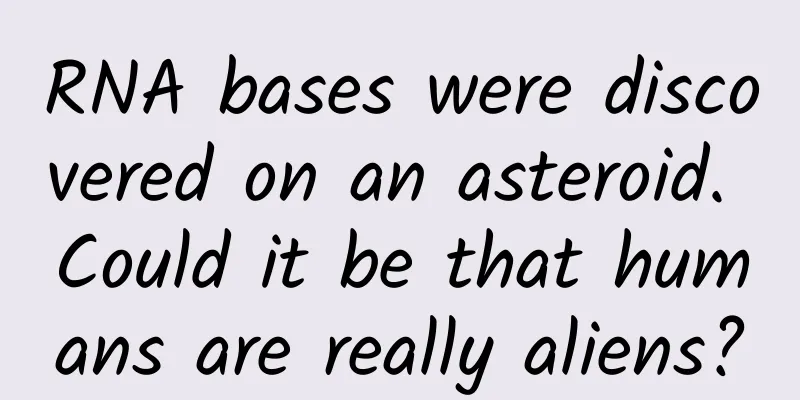RNA bases were discovered on an asteroid. Could it be that humans are really aliens?

|
There has always been controversy over the origin of life on Earth. There are roughly two scientific views on the origin of life. One view is that life is native to Earth, evolving from nothing to something; the other view is that the seeds of life fell from the universe and are from outer space. The theory of native birth and growth holds that life on Earth evolved gradually from inorganic matter in a long and complex chemical process. When the Earth was born 4.5 billion years ago, there was no life, only inorganic matter. Later, after experiencing long-term wind, rain, thunder, lightning, volcanic eruptions and other disturbances, inorganic matter gradually evolved into organic matter, small molecules gradually evolved into organic macromolecules, and macromolecules gradually aggregated into proteins and ribonucleic acid, and then evolved into primitive life. The alien theory holds that there are seeds of life in the universe itself, such as bacterial spores, seeds of animals and plants, etc. These seeds of life are likely to be planets with life, which were destroyed by cosmic events and left floating in the universe. They fell to the earth through meteorites and cosmic dust, and from then on took root, sprouted and bore fruit, evolving into their present form. So far, it is still unclear which of these two views will win. However, some major discoveries in space exploration in recent years seem to have provided more support for the idea that life comes from the universe. Although no signs of life have been found in the universe, many organic substances and even macromolecules have been found, which shows that at least in the process of inorganic to organic evolution on Earth, it is likely to be more influenced by extraterrestrial visitors. Recently, the Japanese scientific community announced that by analyzing the samples collected from the asteroid by the "Hinayana 2" spacecraft, the main bases of RNA were discovered, which undoubtedly adds weight to the theory of alien visitors. The study was led by Yasuhiro Ohba of Hokkaido University and Toshiaki Takano of the Japan Agency for Marine-Earth Science and Technology. Using newly developed small-scale analysis technology, they analyzed samples collected from two locations on the asteroid Ryugu. They detected uracil, niacin (VB3) and some other organic molecules, extracted them, and obtained their concentrations and distribution in the soil of Ryugu. In addition to uracil, the research team also detected four other bases, namely adenine, guanine, cytosine, and thymine. The first three plus uracil are the four main bases that make up RNA, and uracil replaces thymine in DNA. RNA is the ribonucleic acid responsible for guiding protein synthesis in the body. Protein is the most important basis for synthesizing life. Without protein, there is no life. Therefore, analysis of samples obtained from the "Ryugu" asteroid has proved that the universe is full of organic macromolecules that are closest to the synthesis of life. This at least shows that after the birth of the earth, it did not need to go through a long process of evolution from inorganic matter to organic matter, but instead had obtained enough organic macromolecules since the period of meteorite bombardment in the early days of its birth, thus greatly shortening the process of evolving life. So, is it possible that even the transition from organic macromolecules to life was skipped, and the seeds of life fell directly from the sky? I think it is possible, but at least there is no evidence at present. The logical reasoning behind the idea that life fell from the sky is this: If the Earth were destroyed by a huge celestial event one day and shattered into pieces, even if all life on Earth was destroyed, the remains of the corpses of animals, plants, and even microorganisms, or genetic information and bacterial spores would be frozen in the cold space. If these life information drifts to the vicinity of a planetary system, they may fall onto the planet in the form of meteorites or dust. If the planet is habitable, these seeds of life may be revived there. This theory may be able to explain the origin of life on Earth, but it cannot explain where the earliest and most primitive life came from. From the Big Bang to the emergence of stars and planets, there must not have been an event like "the earth was broken" at the beginning. Therefore, the earliest origin of life still has to go back to the chemical evolution theory from nothing to something. Therefore, the study of the origin of life is still long and brain-burning. What do you think? Welcome to discuss. [Extended reading: Introduction to the Hayabusa and Hayabusa 2 spacecraft] Both spacecraft are asteroid probes launched by the Japan Aerospace Exploration Agency. The mission of Hayabusa is to survey and collect samples from an asteroid numbered 25143, nicknamed "Itokawa", and send the samples back to Earth. Hayabusa was launched on May 9, 2003, and arrived near "Itokawa" in July 2005 and captured the asteroid. It landed on "Itokawa" in November to survey and collect samples. During the period, it lost contact several times and suffered a series of failures. Fortunately, it finally completed the sampling mission and began its return journey on April 25, 2007. It took seven years and traveled nearly six billion kilometers to collect samples from the asteroid "Itokawa" 290 million kilometers away from the Earth and returned to Earth. It arrived over Australia on June 13, 2010, and after throwing the insulated capsule containing the samples and landing on the Australian continent, the mission ended with sparks as the main body burned up in the atmosphere. "Hayabusa 2" is the successor sister probe of "Hayabusa". It is of similar size, but has learned from the lessons of "Hayabusa" and made some improvements. For example, it will fire a metal bullet to create a crater and dust before sampling to make sampling easier; and it has added a reaction wheel to avoid the malfunction that occurred in "Hayabusa". The mission of Hayabusa 2 is to approach the asteroid 1999 JU3, nicknamed "Ryugu", to inspect and land on its surface to collect samples, and then bring the samples back to Earth. Hayabusa 2 was launched on December 3, 2014, arrived at Ryugu in June 2018, landed on Ryugu in February 2019 and collected some samples; in April 2019, Hayabusa 2 fired a metal bullet at the surface of Ryugu, creating an impact crater about 10 meters wide, and then the probe collected the material stirred up by the bullet. On November 13, 2019, Hayabusa 2 completed its mission of sampling Ryugu and began its return to Earth. On December 5, 2020, after six years of lonely missions in space and a journey of about 5 billion kilometers, Hayabusa 2 returned to Earth's home, separated the recovery capsule containing Ryugu samples from the main body, and landed in the Australian desert. Unlike the fate of Hayabusa, Hayabusa 2 did not end its mission with the spark of heroic sacrifice. Instead, it used its remaining fuel to change its flight orbit and fly towards an asteroid numbered 1998 KY26. It will arrive there in 2031 and contribute its final strength to human exploration. The two probes have achieved great success. Hayabusa was the first probe to bring back samples from an asteroid, while Hayabusa 2 was the first to discover the source of life - amino acids - in sand samples brought back from an asteroid, confirming for the first time the existence of amino acids in the universe outside the Earth. Scientists have also obtained many world-first research results from the exploration experiences of these two probes and the samples they brought back. These results have been published in the world's top scientific journals such as Science, and have played a significant and positive role in human research on outer space, asteroids and life. This is an original article from Space-Time Communication. Please respect the author’s copyright. Thank you for your understanding and support. |
<<: Does mouth breathing really make people ugly? What dentists have to say!
>>: Can looking at green really protect your eyesight? I have been deceived for many years...
Recommend
What does the time depth isolation experiment that drives people crazy want to prove? Does time really exist?
Recently, there has been a lot of discussion onli...
Why hasn't Microsoft made a good smartphone despite spending so much money?
In the second half of 2011, Lumia 800 was launche...
100 light years away, a "perfect solar system" was discovered
Author: Duan Yuechu Your browser does not support...
Deloitte Consulting: Generative Artificial Intelligence Report, Q2 2024
Value creation The proportion of organizations re...
Why did LeTV Super TV win the Double 11 championship for three consecutive times?
On November 11, 2014, LeTV Super TV’s total sales...
SEM Novice Tutorial: What data do bidders usually analyze?
Those who have worked in the SEM industry should ...
Methodology! How operators can take advantage of hot topics to plan events!
The operations department plans activities based ...
I received a box of hairy crabs, but I can’t finish them. What should I do?
"When the autumn wind blows, the crabs' ...
Analyst: Apple may be late or even miss the automotive feast
Apple Inc. (AAPL) recently acquired a number of c...
How to make the most of your Google Ads budget? Share 4 tips!
You can run an advertising campaign even with a d...
Wildfires spread across Hollywood, but the pictures you see may be generated by AI | Environmental Trumpet
Hello everyone, this is the 25th issue of the Env...
The underlying design logic of App brand advertising
Written in front This article uses a typical bran...
Big players frequently flirt with each other, has the spring of small and medium-sized brand mobile phones arrived?
Recently, China Mobile held a global partner conf...
The State Administration for Market Regulation requires that the packaging of rice dumplings should not exceed 3 layers! What are the specific regulations? Attached is a minimalist method of making rice dumplings!
Zongzi is one of the foods celebrated during the ...
The CTO behind a technical team of 1,000 people: CTO training is far more than technical training
[51CTO.com original article] While most technical...









